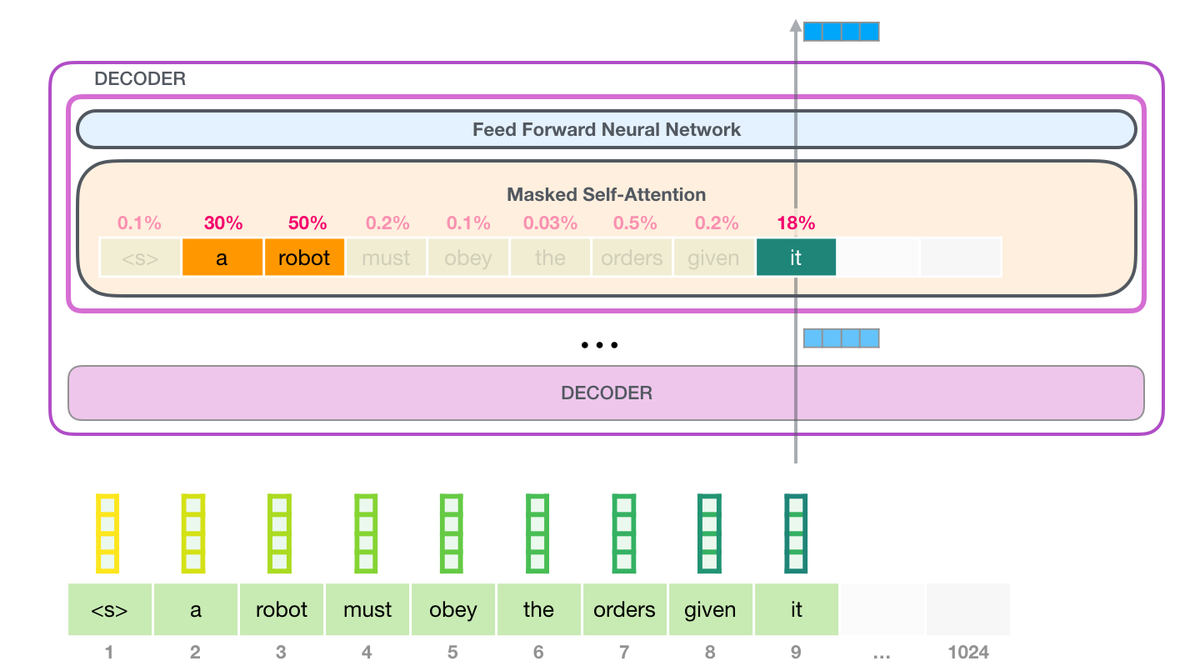How GPT3 works. A visual thread.
A trained language model generates text.
We can optionally pass it some text as input, which influences its output.
The output is generated from what the model "learned" during its training period where it scanned vast amounts of text.
1/n
A trained language model generates text.
We can optionally pass it some text as input, which influences its output.
The output is generated from what the model "learned" during its training period where it scanned vast amounts of text.
1/n
Training is the process of exposing the model to lots of text. It has been done once and complete. All the experiments you see now are from that one trained model. It was estimated to cost 355 GPU years and cost $4.6m.
2/n
2/n
The dataset of 300 billion tokens of text is used to generate training examples for the model. For example, these are three training examples generated from the one sentence at the top.
You can see how you can slide a window across all the text and make lots of examples.
3/n
You can see how you can slide a window across all the text and make lots of examples.
3/n
The model is presented with an example. We only show it the features and ask it to predict the next word.
The model's prediction will be wrong. We calculate the error in its prediction and update the model so next time it makes a better prediction.
Repeat millions of times
4/n
The model's prediction will be wrong. We calculate the error in its prediction and update the model so next time it makes a better prediction.
Repeat millions of times
4/n
Now let's look at these same steps with a bit more detail.
GPT3 actually generates output one token at a time (let's assume a token is a word for now).
5/n
GPT3 actually generates output one token at a time (let's assume a token is a word for now).
5/n
Please note: This is a description of how GPT-3 works and not a discussion of what is novel about it (which is mainly the ridiculously large scale). The architecture is a transformer decoder model based on this paper https://arxiv.org/pdf/1801.10198.pdf @peterjliu @lukaszkaiser
GPT3 is MASSIVE. It encodes what it learns from training in 175 billion numbers (called parameters). These numbers are used to calculate which token to generate at each run.
The untrained model starts with random parameters. Training finds values that lead to better predictions.
The untrained model starts with random parameters. Training finds values that lead to better predictions.
These numbers are part of hundreds of matrices inside the model. Prediction is mostly a lot of matrix multiplication.
In my Intro to AI on YouTube, I showed a simple ML model with one parameter. A good start to unpack this 175B monstrosity
8/n
In my Intro to AI on YouTube, I showed a simple ML model with one parameter. A good start to unpack this 175B monstrosity
8/n
To shed light on how these parameters are distributed and used, we'll need to open the model and look inside.
GPT3 is 2048 tokens wide. That is its "context window". That means it has 2048 tracks along which tokens are processed.
9/n
GPT3 is 2048 tokens wide. That is its "context window". That means it has 2048 tracks along which tokens are processed.
9/n
Let's follow the purple track. How does a system process the word "robotics" and produce "A"?
High-level steps:
1- Convert the word in a vector (list of numbers) representing the word: https://jalammar.github.io/illustrated-word2vec/
2- Compute prediction
3- Convert resulting vector to word
10/n
High-level steps:
1- Convert the word in a vector (list of numbers) representing the word: https://jalammar.github.io/illustrated-word2vec/
2- Compute prediction
3- Convert resulting vector to word
10/n
HORRIFIED to realize GPT3 could be using embedding vectors of size 12,288. Extrapolating from how d_model and d_embd are the same in GPT2. Could this be?
Help @gdb @julien_c
11/n
Help @gdb @julien_c
11/n
The important calculations of the GPT3 occur inside its stack of 96 transformer decoder layers.
See all these layers? This is the "depth" in "deep learning".
Each of these layers has its own 1.8B parameter to make its calculations.
12/n
See all these layers? This is the "depth" in "deep learning".
Each of these layers has its own 1.8B parameter to make its calculations.
12/n
You can see a detailed explanation of everything inside the decoder in my blog post "The Illustrated GPT2": https://jalammar.github.io/illustrated-gpt2/
The difference with GPT3 is the alternating dense and sparse self-attention layers (see https://arxiv.org/pdf/1904.10509.pdf).
13/n
The difference with GPT3 is the alternating dense and sparse self-attention layers (see https://arxiv.org/pdf/1904.10509.pdf).
13/n
This thread now has a proper home on my blog: https://jalammar.github.io/how-gpt3-works-visualizations-animations/
I will keep updating it as I create more visuals.
14/n
I will keep updating it as I create more visuals.
14/n

 Read on Twitter
Read on Twitter




